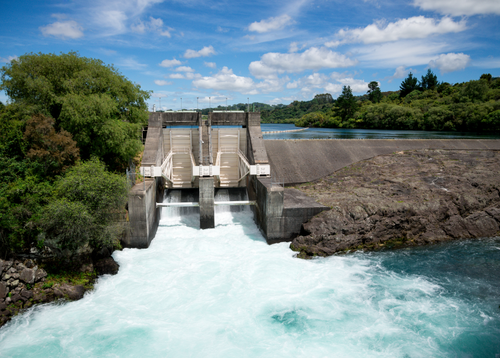Transmission
The transmission system is known as 'the grid'. Electricity is transported across New Zealand through the grid to local substations and then to homes and businesses.
On this page —
About the grid
The national grid or transmission system transports electricity at high‑voltage from power stations, where it is generated, to large industrial users and local substations. The electricity is then delivered by lines companies (also called distributors or network companies) through local networks to homes and businesses.
The grid is owned, operated, maintained and developed by Transpower, a state-owned enterprise.
Transpower's national grid operating centres operate the grid in real time. They charge a fee to the lines companies for use of the transmission network. These fees are regulated by the Commerce Commission. Lines companies pass on the transmission fee to retailers.
New Zealand's grid
The grid is made up of over 11,000 kilometres of high‑voltage transmission lines, 25,000 pylons that hold them, and 170 substations.
Electricity is transported at high voltage (up to 220,000 volts) through a high‑voltage alternating current system around New Zealand.
To transfer electricity between the North and South Island, there is a high‑voltage direct current (HVDC) inter‑island cable with a transmission line under the Cook Strait. Electricity generated in the South Island is often transported north via the HVDC cable, as the North Island has higher electricity demand.
Our role
We work with the grid owner (Transpower) to ensure the grid meets the required reliability and service levels. We are also responsible for transmission pricing policy to promote the efficient day-to-day operation of the wholesale electricity market.
Transmission pricing methodology (TPM) ensures that Transpower can recover the costs of running the grid from transmission customers. (See Schedule 12.4 of the Code.)
We are responsible for approving the TPM. Transpower is required to develop and publish transmission prices consistent with the TPM. About transmission pricing methodology
Transpower must demonstrate to the Electricity Authority that transmission prices are audited and consistent with the TPM. (See clause 12.96 of the Code.)
Transpower provides a directors' compliance statement and an independent assurance report to the Electricity Authority every year to demonstrate that transmission prices are consistent with the TPM. See Transpower's compliance statement 2020-21
The grid owner
As a state-owned enterprise, Transpower is required to operate as a successful business, including earning a commercial return on its assets. However, Transpower is also subject to the Commerce Commission administered targeted price control regime. This aims to limit the ability of lines companies to exercise monopoly power, and increase incentives on these businesses to improve efficiency and share efficiency gains with consumers.
Transpower is responsible for grid planning and management. They also propose transmission investments to the Commerce Commission, report on asset management plans and forecast grid capabilities.
Transpower has contracts with transmission customers who are directly connected to the grid eg, generators, distributors and large industrial companies. Transmission customers are required to have an agreement for the provision of transmission services. (See clauses 12.8 - 12.25 of the Code.)
Grid management
Part 12 of the Code sets out the requirements for grid management. It sets out the rules for how the system operator (Transpower) provides the grid its capacity and direction of flow, as well as how the system operator can change aspects of the grid.
Transpower can permanently reconfigure the grid if it results in a net benefit. Transpower can temporarily reconfigure the grid, if doing so would improve security of supply.
Transpower may temporarily remove any grid assets from service or reduce their capacity, as well as plan and carry out outages, as per the outage protocol.
Eye on electricity
